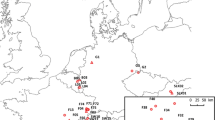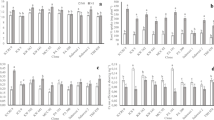Abstract
In a common garden, we investigated genetic and environmental influences on alkaloid production using Sanguinaria canadensis as a model. Nutrient and shade regimes were applied to replicated clones over one growing season, and induction of alkaloid production in bloodroot was tested on a whole-plant basis using jasmonic acid as an elicitor. Alkaloid concentrations increased with decreasing light intensity and fertilizer levels. Induction was not achieved by foliar application of jasmonic acid. Genetic influences represented by clone effects may be indicated by variation in alkaloid concentration by clone, but this experimental design did not allow us to distinguish genetic from pre-experiment environmental influences on the rhizomes.
Similar content being viewed by others
REFERENCES
ANONYMOUS. 1996. Statistical Analysis Software. Version 6.12. SAS Institute, Carey, NC.
AERTS, R. J., GISI, D., DECAROLIS, E., DELUCA, V., and BAUMANN, T. W. 1994. Methyl jasmonate vapor increases the developmentally controlled synthesis of alkaloids in Catharanthus and Cinchona seedlings. Plant J. 5:635–642.
AGRESTI, A. 1996. An Introduction to Categorical Data Analysis. Wiley, New York.
AGRAWAL, A. A. 1998. Induced responses to herbivory and increased plant performance. Science 279:1201-1202.
ARNASON, J. T., GUÈRIN, B., KRAML, M. M., MEHTA, B., REDMOND, R. W., and SCIANO, J. C. 1992. Phototoxic and photochemical properties of sanguinarine. Photochem. Photobiol. 55:35-38.
BALDWIN, I. T. 1996. Methyl lasmonate-induced nicotine production in Nicotiana attenuata: Inducing defenses in the field without wounding. Ent. Exp. et Appl. 80:213-220.
BALDWIN, I. T. 1998. Jasmonate-induced responses are costly but benefit plants under attack in native populations. Proc. Natl. Acad. Sci. USA 95:8113-8118.
BALDWIN, I. T., GORHAM, D., SCHMELZ, E. A., LEWANDOWSKI, C. A., and LYNDS, G. Y. 1998. Allocation of nitrogen to an inducible defense and seed production in Nicotiana attenuata. Oecologia 115:541-552.
BEATTIE, A. J., and CULVER, D. C. 1981. The guild of myrmecochores in the herbaceous flora ofWest Virginia forests. Ecology 62:107-115.
BRYANT, J. P., CHAPIN III, F. S., and KLEIN, D. R. 1983. Carbon-nutrient balance of plants in relation to vertebrate herbivory. Oikos 40:357-368.
CLINE, S. D., McHALE, R. J., and COSCIA, C. J. 1993. Differential enhancement of benzophenanthridine alkaloid content in cell-suspension cultures of Sanguinaria canadensis under conditions of combined hormonal deprivation and fungal elicitation. J. Nat. Prod. 56:1219-1228.
COLEMAN, J. S., and JONES, C. G. 1991. A phytocentric perspective of phytochemical induction by herbiovres, pp. 3-46, in D. W. Tallamy and M. J. Raupp (eds.). Phytochemical Induction by Herbivores. Wiley, New York.
COLEY, P. D., BRYANT, J. D., and CHAPIN III, F. S. 1985. Resource availability and plant antiherbivore defense. Science 230:895-899.
DOWNUM, K. R. 1992. Tansley Review No. 43: Light-activated plant defense. New Phytol. 122:401-420.
EILERT, U. 1998. Induction of alkaloid biosynthesis and accumulation in plants and in vitro cultures in response to elicitation, pp. 219-238, in M. F. Roberts and M.Wink (eds.). Alkaloids: Biochemistry, Ecology, and Medicinal Applications. Plenum, New York.
FACCHINI, P. J., JOHNSON, A. G., POUPART, J. J. and DELUCA, V. 1996. Uncoupled defense gene expression and antimicrobial alkaloid accumulation in elicited opium poppy cell cultures. Plant Physiol. 111:687-697.
FAGERSTROM, T., LARSSON, S., and TENOW, O. 1987. On optimal defense in plants. Funct. Ecol. 1:73-81.
FEENY, P. 1976. Plant apparency and chemical defense, pp. 1-14, in J. Wallace and R. Mansell (eds.). Biochemical Interactions Between Plants and Insects: Recent Advances in Phytochemistry, Vol. 10, Plenum, New York.
GUNDLACH, J., MULLER, M. J., KUCHAN, T. M., and ZENK, M. H. 1992. Jasmonic acid is a signal transducer in elicitor-induced plant cell cultures. Proc. Natl. Acad. Sci. 89:2389-2393.
HASHIMOTO, Y., OKADA, M. I., SHOME, U., and KATO, A. 1986. The analysis of cell contents of some papaveraceous plants by newly devised automated histochemical chromatography. Anal. Lett. 19:2253-2260.
HERMS, D. A., and MATTSON, W. J. 1992. The dilemma of plants: To grow or defend. Q. Rev. Biol. 67:283-334.
IGNATOV, A., CLARK, W. G., CLINE, S. D., PSENAK, M., KRUEGER, R. J., and COSCIA, J. 1996. Elicitation of dihydrobenzophenanthridine oxidase in Sanguinaria canadensis cell cultures. Phytochemistry 43:1141-1144.
KARBAN R., AGRAWAL, A. A., and MANGEL, M. 1997. The benefits of induced defenses against herbivores. Ecology 78:1351-1355.
LEVIN, D. 1976. Alkaloid-bearing plants: An ecogeographic perspective. Am. Nat. 110:261-284.
LYON, D. L. 1992. Bee pollination of facultatively xenogamous Sanguinaria canadensis L. Bull. Torrey. Bot. Soc. 119:368-375.
MAHADY, G. B., SCHILLING, A. B., and BEECHER, C. W. W. 1993. Sanguinaria canadensis L. (Sanguinarius): In vitro culture and the production of benzophenanthridine alkaloids, pp. 313-327, in Y. P. S. Bajaj (ed.). Biotechnology in Agriculture and Forestry. Vol. 24: Medicinal and Aromatic Plants V. Springer-Verlag, Berlin.
MADDOX, G. D., and CAPPUCCINO, N. 1986. Genetic determination of plant susceptibility to a herbivorous insect depends on environmental context. Evolution 40:863-866.
MARINO, P. C., EISENBERG, R. M., and CORNELL, H. V. 1997. Influence of sunlight and soil nutrients on clonal growth and sexual reproduction of the understory perennial herb Sanguinaria canadensis L. Bull. Torrey Bot. Soc. 124:219-227.
MILLER, J. S., and FEENY, P. 1983. Effects of benzylisoquinoline alkaloids on the larvae of polyphagous Lepidoptera. Oecologia 58:332-339.
RALPHS, M. H., MANNERS, G. D., and GARDNER, D. R. 1998. Influence of light and photosynthesis on alkaloid concentration in larkspur. J. Chem. Ecol. 24:167-182.
ROBERTS, M. F. 1998. Enzymology of alkaloid biosynthesis, pp. 109-146, in M. F. Roberts and M. Wink (eds.). Alkaloids: Biochemistry, Ecology, and Medicinal Applications. Plenum, New York.
SAITO, K., and MURAKOSHI, I. 1998. Genes in alkaloid metabolism, pp. 147-158, in M. F. Roberts and M. Wink (eds.). Alkaloids: Biochemistry, Ecology, and Medicinal Applications. Plenum, New York.
SCHMELLER, T., LATZ-BRUNING, B., and WINK, M. 1997. Biochemical activites of berberine, palmatine, and sanguinarine mediating chemical defense against microorganisms and herbivores. Phytochemistry 44:257-266.
SULTAN, S. E. 1995. Phenotypic plasticity and plant adaptation. Acta Bot. Neerl. 44:363-383.
THALER, J. S. 1999. Induced resistance in agricultural crops: Effects of Jasmonic acid on herbivory and yield in tomato plants. Environ. Entomol. 28:30-37.
THALER, J. S., FIDANTSEF, A. L., DUFFEY, S. S., and BOSTOCK, R. M. 1999. Trade-offs in plant defense against pathogens and herbivores: A field demonstration of chemical elicitors of induced resistance. J. Chem. Ecol. 25:1597-1609.
THALER, J. S., STOUT, M. J., KARBAN, R., and DUFFEY, S. S. 1996. Exogenous jasmonates simulate insect wounding in tomato plants (Lycopersicon esculentrum) in the laboratory and field. J. Chem. Ecol. 22:1767-1781.
THORNE, E. M., BOULWARE, R. T., HARKRADER, R. J., and SOUTHARD, G. L. 1986. HPLC analysis of sanguinarine in oral health care products. J. Soc. Cosmet. Chem. 37:279-286.
TUOMI, J., NIEMELA, P., and HAUKIOJA, E. 1984. Nutrient stress: An explanation for plant anti-herbivore responses to defoliation. Oecologia 61:208-210.
VAN DAM, N. M., VANDERMEIJDEN, E., and VERPOORTE, R. 1993. Induced responses in 3 alkaloidcontaining plant-secies. Oecologia 95:425-430.
WALLER, G. R., and NOWACKI, E. K. 1978. Alkaloid Biology and Metabolism in Plants. Plenum, New York.
WINK, M., and ROBERTS, M. F. 1998. Compartmentation of Alkaloid Synthesis, Transport, and Storage, pp. 239-262, in Alkaloids: Biochemistry, Ecology, and Medicinal Applications. Plenum, New York.
Author information
Authors and Affiliations
Rights and permissions
About this article
Cite this article
Salmore, A.K., Hunter, M.D. Environmental and Genotypic Influences on Isoquinoline Alkaloid Content in Sanguinaria canadensis. J Chem Ecol 27, 1729–1747 (2001). https://doi.org/10.1023/A:1010448406809
Issue Date:
DOI: https://doi.org/10.1023/A:1010448406809




